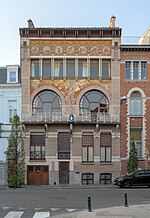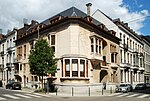Avenue Louise

The Avenue Louise (French) or Louizalaan (Dutch) is a major thoroughfare in Brussels, Belgium. It is located in the southern part of the City of Brussels, on the border with the municipality of Ixelles, where it runs south–east from the Place Louise/Louizaplein to the Bois de la Cambre/Ter Kamerenbos, covering a distance of 2.7 km (1.7 mi). It is named in honour of King Leopold II's eldest daughter, Princess Louise (1858–1924). The Avenue Louise is one of the most prestigious and expensive avenues in Brussels, lined with high-end fashion stores and boutiques, however, at night, it becomes an area of unauthorized prostitution. It also houses many embassies and offices. The avenue is served by the metro station Louise/Louiza at one end (on lines 2 and 6), as well as the tram lines 8 and 93, which run its entire length.
Excerpt from the Wikipedia article Avenue Louise (License: CC BY-SA 3.0, Authors, Images).Avenue Louise
Avenue Louise - Louizalaan, City of Brussels
Geographical coordinates (GPS) Address Nearby Places Show on map
Geographical coordinates (GPS)
| Latitude | Longitude |
|---|---|
| N 50.826944444444 ° | E 4.3644444444444 ° |
Address
Tunnel Bailli - Baljuwtunnel
Avenue Louise - Louizalaan
1000 City of Brussels (Brussels)
Belgium
Open on Google Maps








